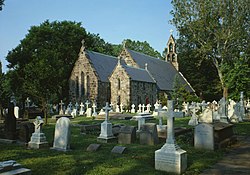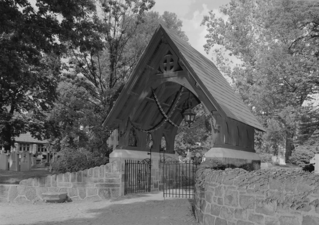
The Episcopal Diocese of Washington is a diocese of the Episcopal Church covering Washington, D.C., and nearby counties of Maryland in the United States. With a membership of over 38,000, the diocese is led by the Bishop of Washington, Mariann Budde. It is home to Washington National Cathedral, which is the seat of both the diocesan bishop and the Presiding Bishop of the Episcopal Church.

The Cathedral Church of St. Paul is the cathedral church of the Episcopal Diocese of Michigan. In 1824 its congregation formed as the first Episcopal and first Protestant church in the Michigan Territory.

St. Stephen's Episcopal Church is a historic parish of the Episcopal Diocese of Pennsylvania, founded in 1823 in Philadelphia, Pennsylvania and located at 19 South Tenth Street, on the corner of Tenth Street and Ludlow Street. St. Stephen's was designed by William Strickland in the Gothic revival style. It is the oldest extant building in Philadelphia in this style and was designed by an architect-engineer best known for Greek Revival buildings, though, like his mentor Benjamin Latrobe, he produced buildings in other "picturesque" styles as well. St. Stephen's first service was held on February 27, 1823. On June 4, 1979, it was added to the National Register of Historic Places. On May 28, 1957, it was designated a historic landmark by the Philadelphia Historical Commission.

St. Mary's Episcopal Church is a historic Episcopal parish in Burlington, Burlington County, New Jersey, United States. The original church was built in 1703. It was supplemented with a new church on adjacent land in 1854. On May 31, 1972, the new church was added to the National Register of Historic Places and on June 24, 1986, it was declared a National Historic Landmark. It is within the Burlington Historic District.
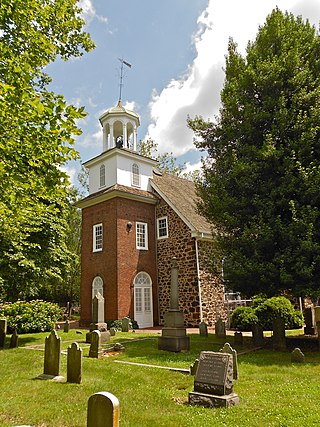
Holy Trinity Church, also known as Old Swedes, is a historic church at East 7th and Church Street in Wilmington, Delaware. It was consecrated on Trinity Sunday, June 4, 1699, by a predominantly Swedish congregation formerly of the colony of New Sweden. The church, designated a National Historic Landmark in 1961, is among the few surviving public buildings that reflect the Swedish colonial effort. The church is considered part of First State National Historical Park. The church, which is often visited by tourists, remains open for tours and religious activities.

Christ Church is an Episcopal church in the Old City neighborhood of Philadelphia. Founded in 1695 as a parish of the Church of England, it played an integral role in the founding of the Protestant Episcopal Church in the United States. In 1785, its rector, William White, became the first Presiding Bishop of the Episcopal Church.

Saint Mark's Episcopal Churchis an Episcopal church located at 1625 Locust Street in Rittenhouse Square in Center City Philadelphia. It is part of the Diocese of Pennsylvania.
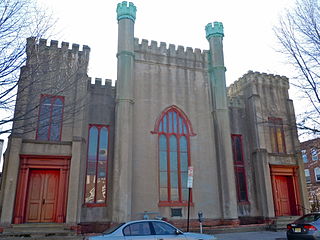
Established in 1703, St. Michael's Church in downtown Trenton, Mercer County, New Jersey, United States, is a founding parish of the Episcopal Diocese of New Jersey. Its present building located at 140 North Warren Street was built in 1747–1748, and was renovated in 1810 and 1847–1848. It was listed on the National Register of Historic Places on April 29, 1982 as St. Michael's Episcopal Church.

St. Joseph's Episcopal Church, now known as St. Matthew's-St. Joseph's Episcopal Church, is a historic Episcopal church located at 8850 Woodward Avenue in Detroit, Michigan, and is part of the Episcopal Diocese of Michigan. It was added to the National Register of Historic Places in 1982.
William Halsey Wood was an American architect.
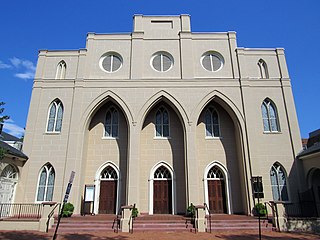
St. Paul's Episcopal Church is an historic Episcopal church in the Anglican Communion located in the Old Town area of Alexandria, Virginia. The church, consecrated in 1818, was designed by Benjamin Latrobe, the second architect of the United States Capitol. It is one of the few buildings designed by Latrobe in a Gothic style and one of the earliest examples of Gothic Revival architecture in the United States. The church was placed on the National Register of Historic Places in 1985. During the year 2009, St. Paul's Episcopal Church celebrated the bicentennial of its founding.

Old Trinity Church, also known as Trinity Church, Oxford, is a historic Episcopal church established in 1696 located in Oxford Township, Pennsylvania, which is now part of Philadelphia.
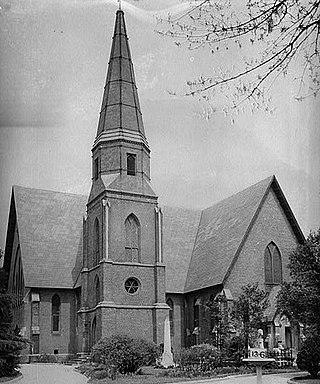
Christ Church (Episcopal) is an Episcopal church in Greenville, South Carolina, United States. which was consecrated in 1854. The church and its courtyard are listed on the National Register of Historic Places as Christ Church (Episcopal) and Churchyard. It is the oldest organized religious body and the oldest church building remaining in Greenville.

Immanuel Episcopal Church is a historic Episcopal church and cemetery located near Mechanicsville, Hanover County, Virginia.
Emlen Trenchard Littell was an American architect known for designing Gothic Revival style churches.
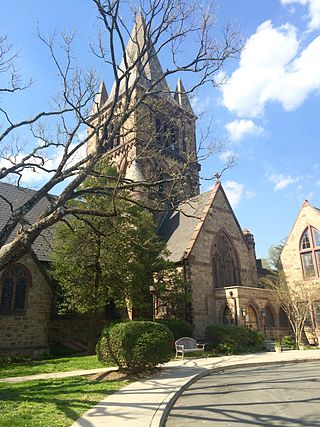
Trinity Church is a historic Episcopal congregation located at 33 Mercer Street in Princeton, New Jersey. It is the largest Episcopal church in New Jersey.

The Church of St. James the Greater is an Episcopal church located in the heart of the Bristol Historic District in Bristol Borough, Pennsylvania. It is part of the Episcopal Diocese of Pennsylvania and the Episcopal Church in the United States of America.

Christ Church, also known as Christ Episcopal Church, is a Christian house of worship located on the corner of Church Street and Main Street in Newton, New Jersey. It is a parish overseen by the Episcopal Diocese of Newark, a diocese of the Episcopal Church in the United States of America. The congregation first met on 28 December 1769 and was granted a charter by New Jersey's last Royal Governor William Franklin on behalf of Britain's King George III. Christ Church is the oldest church in Newton and the third oldest parish in the Diocese of Newark.
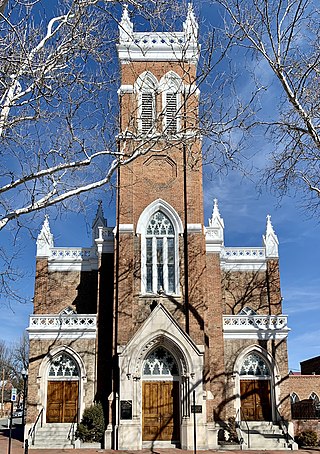
Christ Church, or Christ Episcopal Church, is an Anglican church in Winchester, Frederick County, Virginia. The church was founded in 1738, with its first vestry elected in 1742. It is the seat of Frederick Parish, Diocese of Virginia, which once covered half of the Shenandoah valley and western Virginia, including what became West Virginia. The current church building, the parish's third, was designed by Robert Mills - it was completed in 1828, and is the oldest church building continuously used for religious purposes in the county. It is a contributing building in the local Historic District which predates the National Register of Historic Places, and which has been expanded three times since 1980.
St. David's Episcopal Church is a parish of the Episcopal Diocese of Pennsylvania in the Manayunk neighborhood of Philadelphia, Pennsylvania. It is part of the Wissahickon Deanery of the Diocese of Pennsylvania. In 1960, the parish reported 621 members; it reported 37 members in 2019. English-born mill-workers were heavily represented in its early population, while mill owners were successive wardens, vestrymen, and treasurers.
